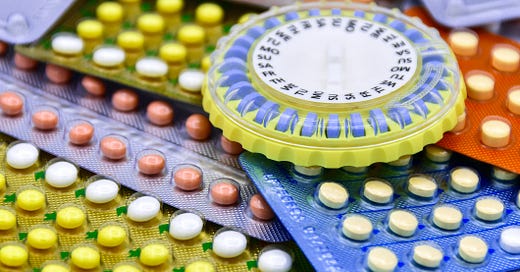Estrogen Containing Contraceptives: The Multitasker of the Menopause Transition
How they stack up to MHT
Getty Images, credit aareya_ann
Estrogen-containing contraception (ECC, which can be a pill, patch, or vaginal ring) can be an important part of managing the menopause transition. If your final period has come and is long gone, they are not the treatment option for you. However, if you are under age 55 and not yet menopausal, they can be very useful and are often an essential part of therapy.
Here, I’ll discuss how estrogen-containing contraceptives work with a specific focus on how their biological effects are particularly useful in the menopause transition. I’ll also review the choices, discuss estrogen doses vs. standard menopausal hormone therapy (MHT), do some troubleshooting, and discuss how to transition to MHT or stop hormones altogether for people who aren’t sure they want or need MHT.
If this is the first post you are reading in our hormone menoverse series, please note that we are quite far along in the series, so check here for the Table of Contents to see what has been covered and what is coming up.
Also, fair warning: this post is quite long. It’s basically a book chapter, but it’s also everything you need to know about the subject in one spot.
Estrogen-Containing Contraceptives: The Basics
Each cycle, a certain number of follicles in the ovaries attain the potential to ovulate (think of this as a VIP pass). One process governs getting the follicles to this point where they are VIP pass eligible, and then another process, controlled by FSH and LH (follicle-stimulating hormone and luteinizing hormone, which are both released by the pituitary in the brain) that results in one follicle from the VIP crowd dominating and eventually ovulating.
Estrogen-containing contraceptives contain estrogen and a progestin, and together, they suppress the hormones FSH and LH. This means the follicles can’t develop past cycle day three, so they hang around, producing the lower estradiol levels typical in the very early part of the cycle. (I think of this as ECCs ripping up the VIP pass). And because LH is suppressed, if one follicle manages to sneak behind the velvet rope and develop, ovulation is prevented. The progestin (progesterone-like hormone) in the ECC thins the endometrium (lining of the uterus), reducing bleeding significantly. If the ECC is taken continuously, there may not be any bleeding at all.
Estrogen-Containing Contraceptives and the Menopause Transition
With menopause, levels of FSH are high, and estradiol levels are low. However, the transition from the menstrual cycle to menopause is not typically an orderly progression, with FSH levels gradually rising and estradiol levels gradually dropping. While it may be this way for some, the changes in hormones are erratic for many. This means FSH levels can be high and estradiol levels low one cycle, looking exactly like menopause, and then the next cycle can look completely normal, far from menopause. Cycles can be shorter, or they can be longer. Cycles can happen even without ovulation. Because there is no predictable pattern during the menopause transition, testing hormone levels to determine where someone is in the menopause transition is useless (and one of my red flags about the quality of medical care you are receiving).
With ECCs, FSH stays suppressed, and ovulation doesn't occur, so the hormonal
Keep reading with a 7-day free trial
Subscribe to The Vajenda to keep reading this post and get 7 days of free access to the full post archives.




